Physically demanding jobs linked to increased odds of knee OA
Occupations with heavy physical labor, such as cleaning, agricultural, service, house and construction work, as well as mining, are associated with greater odds of developing knee osteoarthritis, according to data published in Arthritis Care and Research.
“With rising longevity and the aging population, longer work-life has become more common in industrialized countries,” Xia Wang, MMed, PhD, of the Royal North Shore Hospital at the University of Sydney, and colleagues wrote. “Exposure time to occupational activities is also prolonged, which might increase the risk of OA development.”

“Up-to-date evidence is essential to inform workplace regulators and insurers about specific activities that may be problematic and to identify targeted industrial sectors for developing tailored OA preventive strategies,” they added. “The impetus for greater public attention to workplace health is important for the aging of workforces and facilitating policy changes in many countries that push for longer employment trajectories.”
To analyze the association between certain occupations and knee OA, Wang and colleagues conducted a systematic literature review. Specifically, the researchers examined observations studies that focused on the relationship between occupational exposures, knee OA and total knee replacement. They searched records in four databases from inception until Oct. 1, 2019. Reviewers assessed study quality using the NewcastleOttawa Scale, and evidence quality via the Grading of Recommendations, Assessment, Development and Evaluation (GRADE) system.
In all, the researchers identified 80 studies eligible for inclusion. Among these were 25 case-control studies, with a total of 20,505 participants; 36 cross-sectional studies, with a total of 139,463 participants; and 19 cohort studies, with 16,824,492 participants. The researchers conducted subgroup meta-analyses for important study characteristics and each type of occupational exposure. They estimated odds ratios and confidence intervals using random-effects models.
According to the researchers, a synthesis of 71 studies that combined various physically demanding jobs and occupational activities indicated increased odds of knee OA (OR = 1.52; 95% CI, 1.37-1.69), compared with sedentary jobs and low-exposure workers. The odds of knee OA were greater among males, as well as in industrybased studies and studies assessing lifetime occupational exposures. Specific job titles found to be associated with knee OA included farmers, builders, metal workers and floor layers.
Statistically significantly higher odds of knee OA were also found among miners (OR = 1.47; 95% CI, 1.11-1.95), as well as cleaners, artisans and service workers. In addition, three studies found that full-time housework was statistically significantly associated with increased odds of knee OA. Occupational lifting, kneeling, climbing, squatting and standing were all associated with a higher odds of knee OA, compared to sedentary workers.
“Our systematic review found that physically demanding occupations and activities carried increased odds of knee OA among, in particular, agricultural and construction workers,” Wang and colleagues wrote. “These findings reinforce the importance of occupational exposures in OA, beyond its roles of musculoskeletal injury, and these data should be carried forward to help develop preventions and inform policy in occupational health.”

